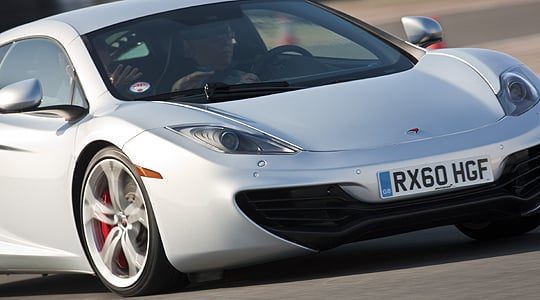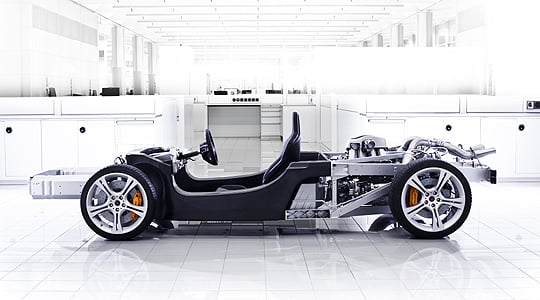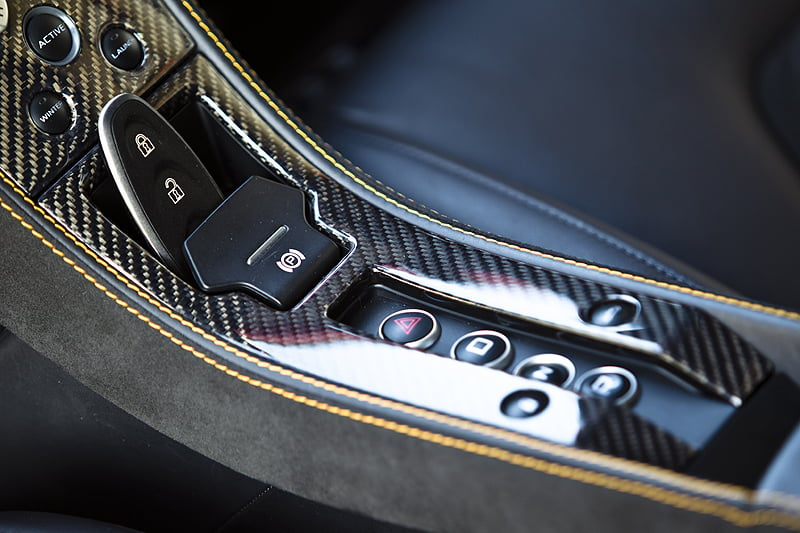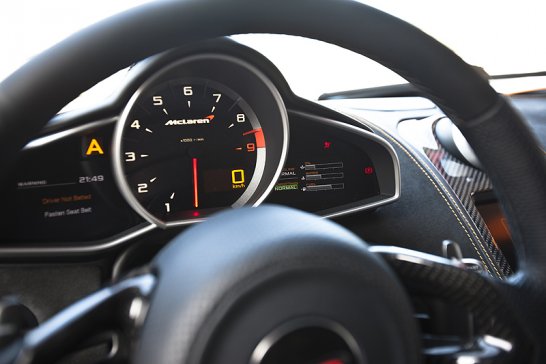
Yes, I have driven it, for a couple of all-too-brief, exhilarating laps at Silverstone. So, too, did John Watson who, 30 years ago at this very track, not only was the first man to win a Grand Prix in a carbonfibre-chassis car but, after a massive accident at Monza later that year, was to soon appreciate the innovative material’s safety properties.
Silverstone was an appropriate location for McLaren Automotive to introduce a few more journalists to the car on every motoring enthusiast’s lips: the MP4-12C. As we have seen, in 1981, Northern Irishman Watson scored a brilliant home GP win here behind the wheel of an MP4-1 Formula One car, the ground-breaking John Barnard design with its all-carbonfibre chassis.
Plus, the exchange of technical information and engineers between the racing and road car divisions is such that what works for an F1 car at Silverstone is, wherever possible, used on the new mid-engined GT. After the Woking company’s innovative early 80s foray into the carbonfibre ‘unknown’ (originally produced for them in the USA by NASA Space Shuttle supplier Hercules), the material soon became standard in F1.

Hence the adoption from the start of the carbonfibre ‘MonoCell’ as the MP4-12C’s central chassis component. The immensely stiff, strong, light (just 75kg) hollow one-piece structure is produced by composite expert CarboTech in Austria. Like its F1 cousin, the new McLaren road car’s carbonfibre mat is unwoven ‘non-crimp’ (that is, ‘straight lines’ of fibre, held together with cross-stitching – the ‘weave’ effect you might see for effect in many road cars is not as strong). But, instead of the pre-impregnated racing method, it’s a ‘dry’ process before liquid resin is injected into the 35-ton steel tool.
Known as Resin Transfer Moulding (RTM), the ground-breaking process produces not only a strong and light structure, it’s also one built to extremely fine tolerances – just 0.5mm across the diagonal after 5-axis, CNC machining. John Barnard was alongside Watson at Silverstone this week, and explained how carbonfibre can be built up in some places and reduced in others. Likewise, the direction of weave can have its own effect on the all-important balance of weight, safety and stiffness. The first torsional test on the 1981 MP4-1’s carbon tub proved it to be 2.5 times as stiff as aluminium, albeit slightly heavy. The second was thinner in places (so lighter) yet still twice as stiff as metal.


McLaren’s standard-setting F1, launched in 1993, was the world’s first all-carbonfibre-chassis road car. The time it took to create the tub for these cars could probably be timed in 100s of hours. Now, with RTM technology, the cycle time of a MonoCell for the MP4-12C in the two-chassis tool is just two hours. And there are no bonded or welded joints, so the bodywork is purely for aerodynamic and packaging purposes.
Which means a convertible can easily be introduced (and is likely to be, sometime next year), as can all-new styling well inside the usual seven years or so life-cycle of ‘conventional', all-metal cars.
McLaren MP4-12C: First Drive
It’s all very clever. And safe, and key to the driving qualities of the MP4-12C...
... which are, on brief experience, pretty extraordinary. Chris Goodwin was my chauffeur for a couple of sighting laps of the short circuit set in the shadow of the new ‘Wing’ structure which will be ready for this year’s GP. A highly experienced racing driver and tester, he’s covered tens of thousands of miles in prototypes and pre-production (the ‘PP’ cars you see here) McLarens since 2006.
Driving at fast road pace, in automatic and then using the ‘rocker’ paddles, Goodwin talks me through the different levels of suspension, aerodynamic and gearbox configuration available at the twist, or press, of a button. I’ll leave the minutiae of these for the full road test, though, as today is just an exquisite taster of the 592bhp supercar.
Entry is via tall, free-swinging gullwing doors activated by a sensor that you ‘swipe’ in the manner of an iPad. The broad, carpet-covered sill is easily negotiated (and makes a handy ‘seat’ itself, with the doors open – I liked that). Naturally, every car can be trimmed to suit the owner’s taste – with more bespoke work available on demand – but the first impression is of just the right level of high quality leather/alloy/carbonfibre; think Bang & Olufsen, if they made cars. A pure design, classily executed. I loved the leather: not too soft, not too hard with a wonderful, fine-grain, ‘satin’ finish.
The driving position is perfect. Straight legs, wheel very vertical in plane and the seat super-comfortable for road or track. Setting off is a simple ‘foot on brake, pull the paddle into first and press the throttle’.

In automatic (for town driving and country lane pootling), life is very straightforward. The dual-clutch, seven-speed ‘SSG’ transmission makes smooth progress, much in the manner of current ‘DSG-type’ 'boxes. Manual gearchanging is via an F1-practice-derived ‘rocking paddle’, rather than the familiar Ferrari/Maserati/Aston set-up of two paddles with only a ‘pull’ function. The rocker rotates with the wheel (F1 again, and takes a little getting used to) and does require a definite pull to activate it.
This is a result of input from Jenson Button, who likes a very positive action, and the gearbox’s ‘pre-cog’ function which will ready the next gear on first click, then select it lightning fast on the second, final click. Like pre-focusing an SLR camera before taking the shot.



Okay, it’s the second lap now and we’re coming in at the end of this one. Really step on the accelerator and the power just builds up. With the rev-counter touching 7000rpm, the car simply steams down the straight. We’re in full track mode and the exhaust is louder – but not intrusively so – and the chassis is in optimum set-up. There’s no BANG! in the back as it hits peak power; it just effortlessly applies relentless thrust to the relatively small-frontal-area (testament again to its efficient MonoCell construction) GT. I didn’t spot it, but Goodwin pointed out that the airbrake had been activated under heavy braking – with both active suspension and aerodynamics there’s so much going on. Although easy to drive, it’s difficult to take it all in, in one go.
We trickle back to the pits and, in equal measures, I’m mightily impressed and desperate for more. They regularly drive the cars to Nardo, in Southern Italy, for high-speed testing. Drive through the night, stopping just for coffees and steak frites, now that would be a road trip...

And I’m not the only one awestruck by the car. Let’s leave the final words to John Watson, a self-proclaimed ‘test pilot’ for carbonfibre racing cars, who declares it to be “mindbogglingly quick... from 80mph to 130mph it seems as fast as the 1980s F1 car... By a million times the quickest road car I’ve ever driven.”
And he kept it on its ‘basic’ road settings, it has to be said. For those of you out there with a car on order, it will be worth the wait.
Text: Steve Wakefield
Photos/Video: McLaren
ClassicInside - The Classic Driver Newsletter
Free Subscription!









